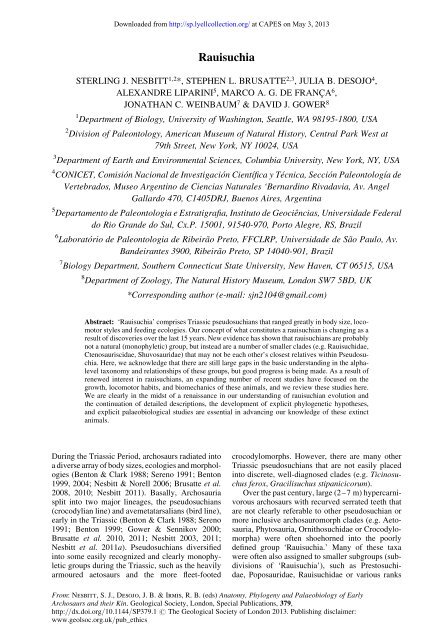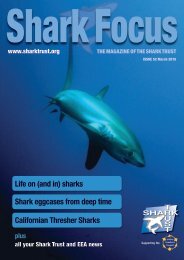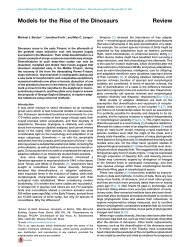Downloaded from http://sp.lyellcollection.org/ at CAPES on May 3, <strong>2013</strong>RauisuchiaSTERLING J. NESBITT 1,2 *, STEPHEN L. BRUSATTE 2,3 , JULIA B. DESOJO 4 ,ALEXANDRE LIPARINI 5 , MARCO A. G. DE FRANÇA 6 ,JONATHAN C. WEINBAUM 7 & DAVID J. GOWER 81 Department of Biology, University of Washington, Seattle, WA 98195-1800, USA2 Division of P<strong>al</strong>eontology, American Museum of Natur<strong>al</strong> History, Centr<strong>al</strong> Park West at79th Stre<strong>et</strong>, New York, NY 10024, USA3 Department of Earth and Environment<strong>al</strong> Sciences, Columbia University, New York, NY, USA4 CONICET, Comisión Nacion<strong>al</strong> de Investigación Científica y Técnica, Sección P<strong>al</strong>eontologíadeVertebrados, Museo Argentino de Ciencias Natur<strong>al</strong>es ‘Bernardino Rivadavia, Av. AngelG<strong>al</strong>lardo 470, C1405DRJ, Buenos Aires, Argentina5 Departamento de P<strong>al</strong>eontologia e Estratigrafia, Instituto de Geociências, Universidade Feder<strong>al</strong>do Rio Grande do Sul, Cx.P. 15001, 91540-970, Porto Alegre, RS, Brazil6 Laboratório de P<strong>al</strong>eontologia de Ribeirão Pr<strong>et</strong>o, FFCLRP, Universidade de São Paulo, Av.Bandeirantes 3900, Ribeirão Pr<strong>et</strong>o, SP 14040-901, Brazil7 Biology Department, Southern Connecticut State University, New Haven, CT 06515, USA8 Department of Zoology, The Natur<strong>al</strong> History Museum, London SW7 5BD, UK*Corresponding author (e-mail: sjn2104@gmail.com)Abstract: ‘Rauisuchia’ comprises Triassic pseudosuchians that ranged greatly in body size, locomotorstyles and feeding ecologies. Our concept of what constitutes a rauisuchian is changing as aresult of discoveries over the last 15 years. New evidence has shown that rauisuchians are probablynot a natur<strong>al</strong> (monophyl<strong>et</strong>ic) group, but instead are a number of sm<strong>al</strong>ler clades (e.g. Rauisuchidae,Ctenosauriscidae, Shuvosauridae) that may not be each other’s closest relatives within Pseudosuchia.Here, we acknowledge that there are still large gaps in the basic understanding in the <strong>al</strong>ph<strong>al</strong>eveltaxonomy and relationships of these groups, but good progress is being made. As a result ofrenewed interest in rauisuchians, an expanding number of recent studies have focused on thegrowth, locomotor habits, and biomechanics of these anim<strong>al</strong>s, and we review these studies here.We are clearly in the midst of a renaissance in our understanding of rauisuchian evolution andthe continuation of d<strong>et</strong>ailed descriptions, the development of explicit phylogen<strong>et</strong>ic hypotheses,and explicit p<strong>al</strong>aeobiologic<strong>al</strong> studies are essenti<strong>al</strong> in advancing our knowledge of these extinctanim<strong>al</strong>s.During the Triassic Period, archosaurs radiated intoa diverse array of body sizes, ecologies and morphologies(Benton & Clark 1988; Sereno 1991; Benton1999, 2004; <strong>Nesbitt</strong> & Norell 2006; Brusatte <strong>et</strong> <strong>al</strong>.2008, 2010; <strong>Nesbitt</strong> 2011). Bas<strong>al</strong>ly, Archosauriasplit into two major lineages, the pseudosuchians(crocodylian line) and avem<strong>et</strong>atars<strong>al</strong>ians (bird line),early in the Triassic (Benton & Clark 1988; Sereno1991; Benton 1999; Gower & Sennikov 2000;Brusatte <strong>et</strong> <strong>al</strong>. 2010, 2011; <strong>Nesbitt</strong> 2003, 2011;<strong>Nesbitt</strong> <strong>et</strong> <strong>al</strong>. 2011a). Pseudosuchians diversifiedinto some easily recognized and clearly monophyl<strong>et</strong>icgroups during the Triassic, such as the heavilyarmoured a<strong>et</strong>osaurs and the more fle<strong>et</strong>-footedcrocodylomorphs. However, there are many otherTriassic pseudosuchians that are not easily placedinto discr<strong>et</strong>e, well-diagnosed clades (e.g. Ticinosuchusferox, Gracilisuchus stipanicicorum).Over the past century, large (2–7 m) hypercarnivorousarchosaurs with recurved serrated te<strong>et</strong>h thatare not clearly referable to other pseudosuchian ormore inclusive archosauromorph clades (e.g. A<strong>et</strong>osauria,Phytosauria, Ornithosuchidae or Crocodylomorpha)were often shoehorned into the poorlydefined group ‘Rauisuchia.’ Many of these taxawere often <strong>al</strong>so assigned to sm<strong>al</strong>ler subgroups (subdivisionsof ‘Rauisuchia’), such as Prestosuchidae,Poposauridae, Rauisuchidae or various ranksFrom: <strong>Nesbitt</strong>, S. J., Desojo, J.B.&Irmis, R. B. (eds) Anatomy, Phylogeny and P<strong>al</strong>aeobiology of EarlyArchosaurs and their Kin. Geologic<strong>al</strong> Soci<strong>et</strong>y, London, Speci<strong>al</strong> Publications, 379,http://dx.doi.org/10.1144/SP379.1 # The Geologic<strong>al</strong> Soci<strong>et</strong>y of London <strong>2013</strong>. Publishing disclaimer:www.geolsoc.org.uk/pub_<strong>et</strong>hics
Downloaded from http://sp.lyellcollection.org/ at CAPES on May 3, <strong>2013</strong>S. J. NESBITT ET AL.associated with Rauisuchidae (e.g. Rauisuchiformes,Parrish 1993). Furthermore, many of thes<strong>et</strong>axa, such as Prestosuchus chiniquensis and Rauisuchustiradentes, were represented only by incompl<strong>et</strong>efossils that provided information on onlysm<strong>al</strong>l portions of the skel<strong>et</strong>on. In addition, sever<strong>al</strong>Triassic pseudosuchians with divergent crani<strong>al</strong>and/orvertebr<strong>al</strong>anatomies (e.g.Lotosaurusadentus,‘Chatterjeea elegans’) were associated with more‘typic<strong>al</strong>’ rauisuchians by virtue of their similar pelvicand hindlimb morphology. As a result, confusionabout what diagnosed rauisuchians and abouttheir relationships to one another and to other pseudosuchiansdominated the literature of the late 20thcentury, and little consensus had been reached. Atthe most basic level, it was not clear if rauisuchianswere a natur<strong>al</strong> group, a paraphyl<strong>et</strong>ic group withrespect to other pseudosuchian clades, or a polyphyl<strong>et</strong>icassemblage spread among more easily recognizedpseudosuchian groups (Gower 2000).Given their gener<strong>al</strong>ly poor fossil record and theabsence of a clear taxonomy, rauisuchians werelargely bypassed in studies of Triassic vertebratemacroevolution until recently (<strong>al</strong>though see Benton1983; Bonaparte 1984). Non<strong>et</strong>heless, rauisuchiansare now attracting an increased level of attentionbecause of a series of recent discoveries of newtaxa and <strong>al</strong>so b<strong>et</strong>ter materi<strong>al</strong> regarding previouslyknown taxa (e.g. Gower 1999; Sen 2005; Sulej2005; Li <strong>et</strong> <strong>al</strong>. 2006; <strong>Nesbitt</strong> & Norell 2006; J<strong>al</strong>il& Peyer 2007; Desojo & Arcucci 2009; França<strong>et</strong> <strong>al</strong>. 2011; Gauthier <strong>et</strong> <strong>al</strong>. 2011; Trotteyn <strong>et</strong> <strong>al</strong>.2011), advances in understanding character statedistributions among pseudosuchians (Brusatte <strong>et</strong> <strong>al</strong>.2010; <strong>Nesbitt</strong> 2011), redescriptions of importantspecimens (<strong>Nesbitt</strong> 2007; Weinbaum & Hungerbühler2007; Brusatte <strong>et</strong> <strong>al</strong>. 2009; Butler <strong>et</strong> <strong>al</strong>. 2011;Lautenschlager & Desojo 2011; Weinbaum 2011),progress in pseudosuchian phylogen<strong>et</strong>ics (Brusatte<strong>et</strong> <strong>al</strong>. 2010; <strong>Nesbitt</strong> 2011) and expansion of agener<strong>al</strong> interest in these fascinating creatures. As aresult of this influx of new research and fossil discoveries,the anatomy, systematics and evolutionaryhistory of rauisuchians are becoming increasinglyclear, <strong>al</strong>though many debates remain.Wh<strong>et</strong>her a natur<strong>al</strong> group or a collection of moredistantly related groups, rauisuchians are importantfor a number of reasons. They were an importantcomponent of Triassic faunas, especi<strong>al</strong>ly duringthe Early–Middle Triassic when ecosystems werestabilizing after the Permo-Triassic extinction and‘modern ecosystems’ were being established (Sues& Fraser 2010). Rauisuchians were an integr<strong>al</strong>part of the initi<strong>al</strong> diversification of Archosauria inthe Early Triassic, but went extinct by the end ofthe Triassic, seemingly quite suddenly and possiblydue to the glob<strong>al</strong> end-Triassic mass extinction(Benton 2004). Some rauisuchians, such asthe sail-backed ctenosauriscids, are some of the earliestarchosaurs to appear in the fossil record andthus help to date the origin of Archosauria, whichis an important c<strong>al</strong>ibration point in many molecularphylogen<strong>et</strong>ic an<strong>al</strong>yses (<strong>Nesbitt</strong> 2003, 2011; Butler<strong>et</strong> <strong>al</strong>. 2011; <strong>Nesbitt</strong> <strong>et</strong> <strong>al</strong>. 2011a; Parham <strong>et</strong> <strong>al</strong>.2012). Furthermore, rauisuchians were part ofnearly <strong>al</strong>l Triassic archosaur assemblages and havebeen found on nearly <strong>al</strong>l portions of Pangaea withLower to Upper Triassic deposits.Rauisuchians were both taxonomic<strong>al</strong>ly and ecologic<strong>al</strong>lydiverse. They include the first large-bodiedcarnivorous reptiles (up to 7 m in length) in the fossilrecord and were som<strong>et</strong>imes were much larger thancontemporary herbivores, which is unusu<strong>al</strong>, becaus<strong>et</strong>he opposite relationship b<strong>et</strong>ween largest predatorand herbivore size usu<strong>al</strong>ly holds in modern terrestri<strong>al</strong>ecosystems (Sookias <strong>et</strong> <strong>al</strong>. 2012). Although mostrauisuchians were massive, quadruped<strong>al</strong> predators(e.g. Batrachotomus kuperferzellensis, Postosuchuskirkpatricki, Prestosuchus chiniquensis, Saurosuchusg<strong>al</strong>ilei), some taxa departed from this bodytype. Some may have been parti<strong>al</strong>ly aquatic (e.g.Qianosuchus mixtus) whereas others were morelightly built and probably biped<strong>al</strong> (e.g. Effigia okeeffeae,Poposaurus gracilis, Shuvosaurus inexpectatus).Other taxa, such as ctenosauriscids and thebeaked Lotosaurus adentus, sported elaborate sailson their backs. Intriguingly, sever<strong>al</strong> rauisuchianswere long misidentified as theropod dinosaursbecause of some remarkable convergences b<strong>et</strong>weenthese groups (e.g. Colbert 1961; Chatterjee 1985,1993; Benton 1986a; <strong>Nesbitt</strong> & Norell 2006;<strong>Nesbitt</strong> 2007; Brusatte <strong>et</strong> <strong>al</strong>. 2009; Bates & Schachner2012). It seems likely, therefore, that rauisuchiansoccupied many ecologic<strong>al</strong> niches that weresubsequently filled by dinosaurs during the Jurassicand Cr<strong>et</strong>aceous (Brusatte <strong>et</strong> <strong>al</strong>. 2008).An understanding of the anatomy, ecology andsystematics of rauisuchians is clearly important forunderstanding the major patterns and processes inTriassic archosaur evolution. At this point in time,however, there are a number of problems thatremain to be resolved. First and foremost, we cannotidentify a rauisuchian by unambiguous synapomorphies,which is key to identifying these anim<strong>al</strong>sin the field or in collections. This point <strong>al</strong>so underscoresa major phylogen<strong>et</strong>ic problem: there are noclear apomorphies that unite <strong>al</strong>l rauisuchianstog<strong>et</strong>her as a clade, and the relationships of sever<strong>al</strong>genera remain unclear. This natur<strong>al</strong>ly prevents aclear understanding of character evolution amongthese anim<strong>al</strong>s.In gener<strong>al</strong>, taxa classic<strong>al</strong>ly referred to as rauisuchiansshare a large skull relative to their body,recurved te<strong>et</strong>h, and a few other character states highlightedby researchers over the past 75 years (Fig. 1).However, these long-assumed ‘key characters’ are




